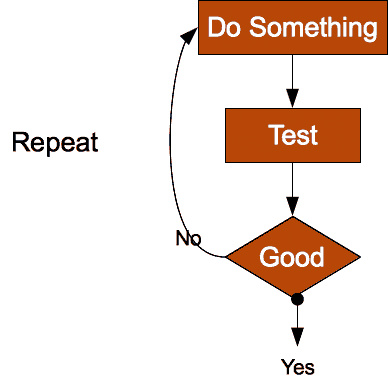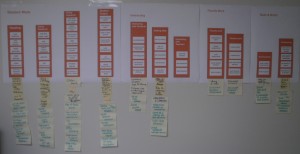Once we moved past discussing a few things it was time to start talking about the process that we will be using to create a new website. The discussion began with a brief discussion of my background from both an educational and professional standpoint. The process that we will be using to create a new website appears on the Outline web page. The outline was created based upon several things that include personal experience, my graduate work at Indiana University, and attending professional workshops.
Here is the outline for the discussion:
- Introduction
- My Background – HCI, Information Architecture, Course Work, Professional Workshops
- Why do you use the Internet?
- Summary:
– Find Information
– Accomplish a Task - Did Not Say:
– Read
– Look at the Design
- Summary:
- Mention Books
- Keep it Simple
- Draw complicated diagram
- Draw simple diagram
- Iterative Cycle

- Design is a Process
- Gather Requirements – INFLUX helped to do this process
- First Thing
– Understanding of who we are?
– Who are they? - Field Study- Interview
– Shadow
– Identify the ‘low-hanging fruit’ – the most important stuff
- First Thing
- Brainstorm Phase One
- Brainstorm Phase Two
- Design & Prototype
- Sketches
- Wire Frame Models
- Build Prototype
- Usability Testing
- Gather Requirements – INFLUX helped to do this process
- Other things we will be doing
- Card Sort
- Developing Information Architecture
After taking a moment to talk about my background we moved into the interactive part of the discussion in which people where asked “Why do you use the Internet?” This was a lively discussion in which everyone had the opportunity to mention a reason or two why they use the internet. Right after I asked this question it was followed up by a question that asked if we were talking about why are patrons use the internet or why we use the internet. The people in the room where reading to much into the question. They were simply asked “Why do you use the Internet?”. There was no reference made to patrons or anybody else.
Here are the reasons why the people who work at the SUNY Potsdam College Libraries use the Internet:
- go to a website
- find information
- chat
- shopping
- communication
- check the weather
- play games
- watch movies/tv
- learn to do something
- understanding
- curiosity
- on-line banking – bill Paying
- relationships
- share stuff
As you read through this list you probably find yourself using the internet to do at least a couple of these things. There may be things that you do that are not here; However, when you take a moment to think about them you will realize that they are very similar in nature to the items listed above. Once we created this list everyone was happy and content with the reasons why we use the Internet.. When we use the internet we typically use it to either find information or accomplish a very specific task. Everyone agreed with this statement and was content at the moment, but that all changed within a matter of a few seconds when we started to talk about the things that were not on the list.
To be continued….

